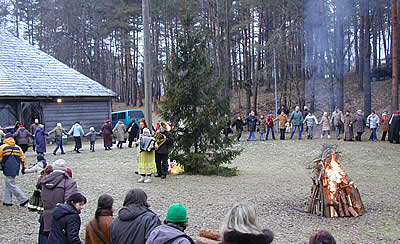

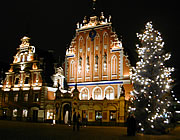
Our second Christmas Market trip and the first to the Baltic States. Riga is beautifully decorated at Christmas time and has much to see apart from the atmospheric Christmas Markets. We also had some very good meals here.
The traditional log pulling was great fun!
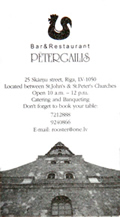
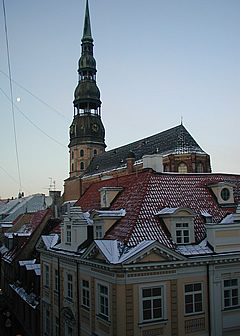
We arrived early evening, collected from the airport in the Hotel Centra's stretch limo - great way to begin a short break! The hotel is very centrally situated on Audeju and very modern inside. It seemed to have been very recently refurbished as everything was pristine and our room was very comfortable with lots of space.
Our first evening we ate at Peter Gailus, close to the hotel, and very much enjoyed the food. I had a Latvian salad, pork with a cep sauce, steakhouse fries and a glass of (Chilean) house red, Andrew deep-fried garlic bread (not great) and very good mushroom and ham fettucine with a Latvian beer - Cesu which he pronounced a bit metallic. The Latvian Zelta on the plane was better! And so to bed.
The following morning we hit the streets.
St. Peter's Church is very close to the hotel and its spire is something of a symbol of the city. Though the current church has changed little since the fourteenth century, the spire has had a more eventful history. The original wooden spire, at 137 feet, was the tallest in Europe at the time it was created in 1491. It collapsed almost two hundred years later, was rebuilt twice in Baroque style and then shelled by the Germans in1941. The current steel 123 ft spire is a replica of the eighteenth century version.
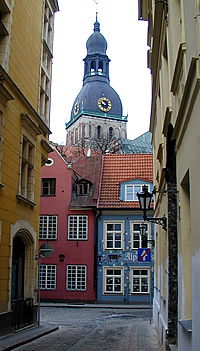
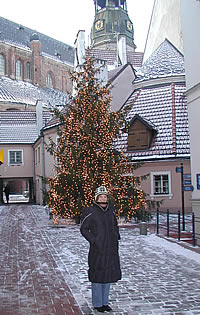
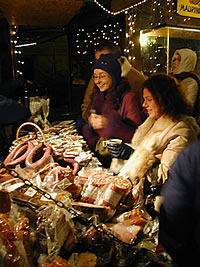
The founder of Riga, Albert von Buxhoeveden, began the building of the cathedral in 1211. Though said to be Romanesque it certainly has many Gothic elements such as the poitned arches and windows in the main body of the buiding. The simplicity of the original cathedral is embellished by later additions of a Renaissance gable at its eastern end and a Baroque belfry.
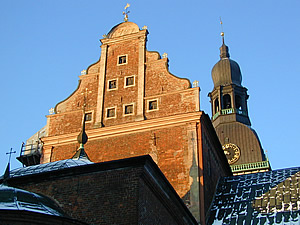
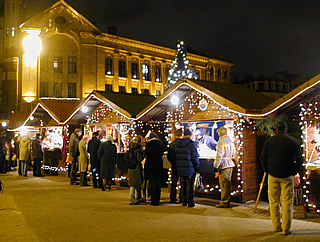
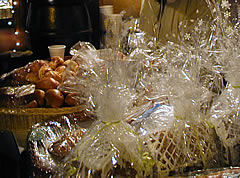
At this time of year the square is crammed with Christmas stalls selling all manner of goods, from sausages to Christmas decorations, with frequent karstvens (hot wine) sellers to fortify shoppers. We tried the local version with black balsam but prefer it without!
Everywhere in the city there are decorated and lit-up Christmas Trees, and a light snowfall created a magical effect.
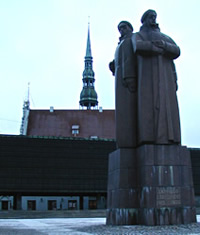
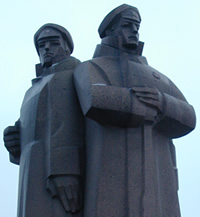
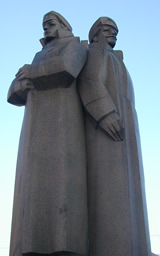
The unit of Latvian Rifleman was created by the Russians in 1915. Riga had been under the rule of Russia since 1709 when the troops of Peter the Great overthrew the Swedes who had in turn been in power since 1621.
The rifleman were often involved in fierce battles and became a source of pride to the indigenous Latvian people. Beginning to resent their use in the firing line, they were easy converts to the Bolshevik cause and were instrumental in bringing Lenin to power in November 1917. Many returned to Latvia but those who served Lenin became his most trusted troops, defending the Kremlin in June 1918 during an attempted coup. It was also Latvians who were ordered to shoot the Tsar and his family at Ekaterinburg on July 16, 1918 (Rough Guide).
The red granite monument of three rifleman in floor length greatcoats in the square is a good example of communist-style sculpture. As you can see. I like it a lot!
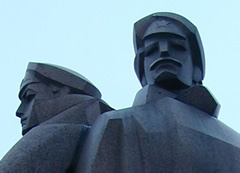
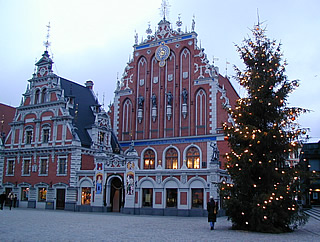
The buildings of the Town Hall Square, where the House of the Blackheads stands, were mostly destroyed in the Second World War.
The House of the Blackheads had developed from a fourteenth century building and its nineteenth century neighbour, built in the same style. First mentioned in historical sources in 1334 as the New House of the Large Guild, it was later let to the guild of unmarried merchants or "Blackheads" named in honour of the Roman warrior-saint Maurice of North African origin, who purchased it in 1713.
The buildings were shelled by the Germans in 1941 and completely demolished by the Russians at the end of the war. These lovely buildings were faithfully rebuilt in time for Riga's eight-hundredth birthday celebrations in 2001.
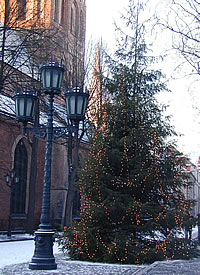
The sunny crisp days were perfect for exploring the city. On the northern edge of the Old Town is the 300 year old long block of St James's Barracks, built by the Swedes and now beautifully converted to shops and cafés. Nearby is the Swedish Gate which didn't make much of an impression. South of the barracks building is the fourteenth century Powder Tower, now part of the War Museum. East of here is the famous Laima Clock, which again we were not very impressed by - so unimpressed we didn't even bother to take a photograph.
We made several attempts to get tickets to see Tosca at the Opera House, had been trying since we'd decided to come here, but we were unsuccessful: it had been completely sold out to a single company.
Lunch at Alus Seta was very good: excellent self-service restaurant where we had chicken kebabs, roast chicken and Latvian-style Rösti plus Latvian beers, Zelta for me and Aldaris for Andrew who declares Zelta the better. The following day tried to have lunch at Vecmeita ar kaki but they didn't seem interested in serving anyone so we left and returned to Alus Seta. We had a siimilar experience one evening when we attempted 1729 (?) for dinner but were shown to a first floor back room with a few tables crammed together and a non-existent atmosphere so we beat a retreat back to Peter Gailus. Here we had another very good meal starting with a champagne cocktail (marred slightly by the waiter bringing the wrong one with the local balsam in it!) and Andrew a cranberry vodka. Then I had a very filling dish of pork fillet layered with cheese and ham and Andrew the pork wih ceps sauce and hot chocolate to finish - not bad at all.
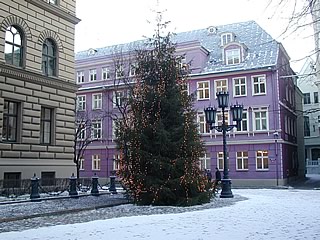
The Menzendorff House is a four storey eighteenth century merchant's house, again beautifully restored to show how a rich merchant would have lived. We also enjoyed the Riga History and Navigation Museum, where a very jolly lady regaled us with stories about the exhibits that we could barely understand.
Nostalgie, a rather elaborate and quite lovely Soviet style café has very good hot chocolate. Though we did have some very good hot chocolate in Riga, it couldn't come up to the standard of the Café Louvre in Prague.
One other very good meal we had was at Melnie Muki - after cocktails at Peter Gailus again, but this time the champagne cocktail was correct, and made with Rigan champagne (or so it said!). I started with salmon and potato pancakes which were excellent, then beef medallions wrapped in bacon (which they didn't need), with lots of "bits" like roasted garlic, shredded white turnip, shaved cucumber, gratin (they know how to do potatoes here!). Andrew had deep-fried camembert with cranberry sauce then strips of beef with mango and ginger stir-fry. It was a huge meal but Andrew managed a triple chocolate terrine to finish and I forced down a hot chocolate - first rate!
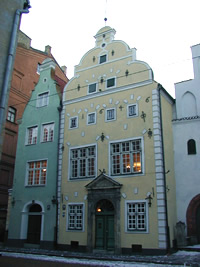
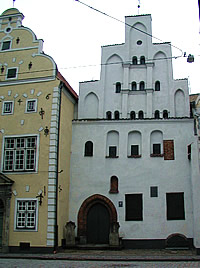
The oldest domestic buildings in Riga, known as the Three Brothers, stand side by side in a narrow street showing off their own distinctive architecture in three very different facades.
The narrow, restrained left-most building is the youngest of the three, having been built in what space remained alongside its yellow-painted neighbour which is a rather elegant seventeenth century town house - the date of 1646 appears in metal work on the facade.
Set a little back from these two the white painted third brother is the oldest of the three, dating from the early fifteenth century. It looks a little slumped but very appealing.
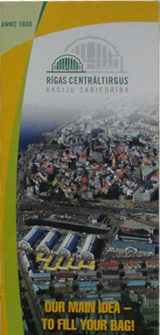
These five vast hangars house what is claimed to be one of the largest markets in the world.
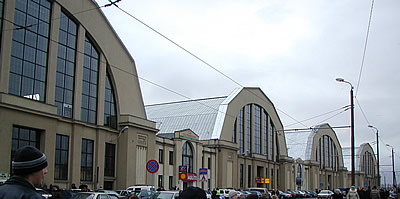
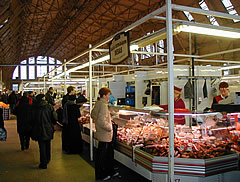
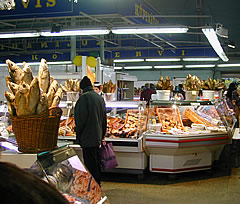
Originally built to house Zeppelins the hangars are a remnant of the German occupation during the First World War. Though of suitable size for a planned market, the city decided that they lacked the necessary hygiene qualities and so the walls and bases were rebuilt but the upper structures were retained.
The project was completed in the autumn of 1930. The largest pavilion at 5000m2 was solely for meat, the other four at 2592m2 each have their own paticular specialty: dairy, groceries, vegetables and fish.
Each of the pavilions has several lifts connecting the retail spaces to storage and freezer space below ground, connected by a network of tunnels to the other pavilions and to landing places on the river.
The huge meat pavilion, set at right angles to the four other pavilions, is an amazing site, accurately reflecting the passion for meat in this city!
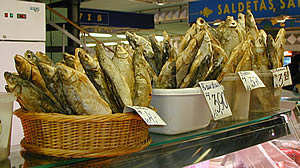
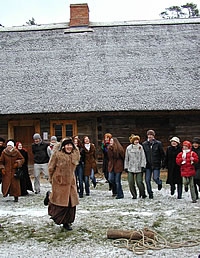
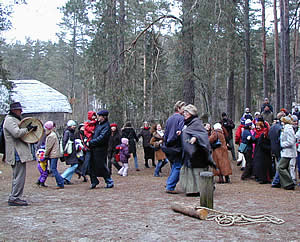
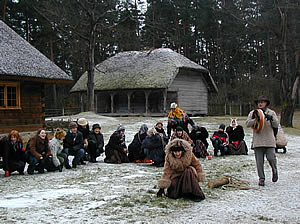
One afternoon we took the bus to the ethnographic museum. If, like me, you enjoy looking at how people live in different countries and times, these types of museum are great. This one has over a hundred traditional buildings from all over the country. The vast majority of these are closed at this time of year but this is made up for by the traditional folk celebrations - apparantly folk groups come from all over Latvia at Christmas to take part. I particularly loved the traditional log pulling - I guess symbolic of bringing fuel for the winter. The log was pulled all around the site with many locals joining in the dancing - great fun. Also hot wine to keep out the cold!
